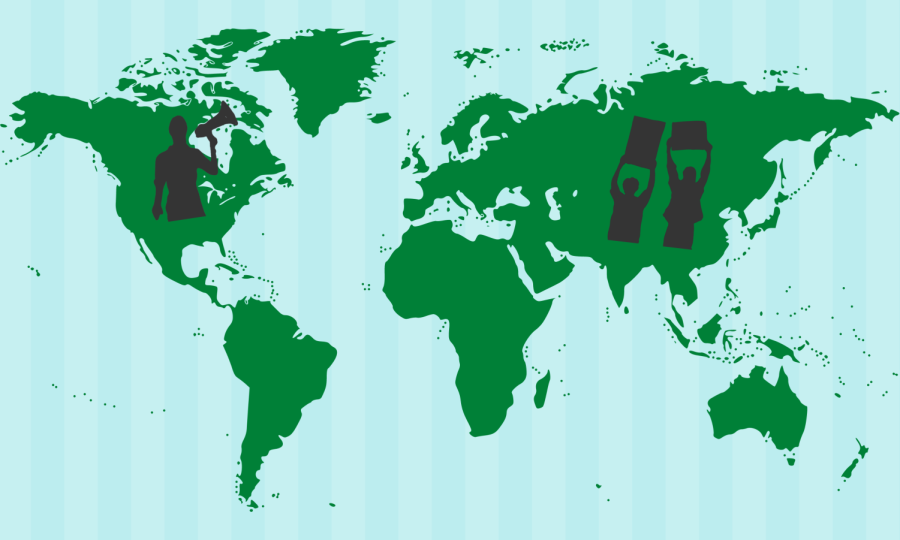Chinese international students view China’s recent easing of Zero-Covid policy as a symbol of hope
Strict COVID-19 restrictions in China resulted in civil rights protests in at least 17 major cities. Protestors raised blank sheets of paper above their heads, symbolic of anti-censorship.
January 18, 2023
China officially reopened its borders to international travelers on Jan. 8, removing the mandatory quarantine policy for inbound travelers. The decision came after nearly three years of strict COVID-19 restrictions that limited travel within the country and prompted protests in at least 17 major cities.
At Northwestern, China is the most represented country among international students, and the news is a relief to many who have not been home or seen their loved ones in years.
When Medill graduate student Cindy Wang left the U.S. during her sophomore year at the University of Southern California to return to Hangzhou, China in March 2020, she had to quarantine for 14 days and pay for the hotel, food and additional expenses herself. The policy dissuaded her from returning to China after starting her senior year at USC in fall 2021.
“You need to pay everything, and then if you get COVID during quarantine, you need to keep quarantining,” Wang said. “And air tickets are really limited and expensive, so I just stayed in the U.S.”
When Wang left China in fall 2021, the country had less than 300 cases, compared to more than a million in the U.S. China attributed their low case numbers to its Zero-Covid policy, which involved frequent testing, a tracking app and strict lockdowns.
Wang’s story is not unique. About half a million international students had not returned to China as of January 2022. Meanwhile, inside the country, others were housebound as cases began to rise — Shanghai residents were under lockdown for two months. Some cities saw rates of suicide and depression shoot up.
“I heard from my friends that a lot of their grandparents didn’t have enough food in Shanghai, and it was just really hard for a lot of families at a time,” she said.
Wang said she feels really lucky. With low case numbers in her region, her family was able to live a relatively normal life within the confines of the province’s borders.
But in China’s capital of Beijing, Medill junior Lucy Dai said her community’s policy was “restrictive” and “controlling.” Residents had to apply for permission to leave their community space and had to return after an hour, Dai said.
“I know that, for my parents, it (was) kind of a harsh thing,” she said. “They (had) to stay in their room for a long period of time, and the only source of community (was) the ones who will bring them food, fruit and vegetables, and everyone was anxious.”
As case numbers rose in the second half of 2022 — triggering longer and more frequent lockdowns — citizens’ frustrations increased. Videos of protests circulated on social media in September with citizens calling for an end to the Zero-Covid policy.
“We had protests before, but the government was compressing them,” Dai said. “So it wasn’t really big until the end of last year. Suddenly, there was something that went on in the Xinjiang province, and everyone was like, ‘We cannot take this anymore.’”
The “something” Dai referred to was an apartment fire in Urumqi, the capital of Xinjiang, in November 2022. Firefighters were delayed in responding due to the lockdown that had been in place for more than 100 days. 10 people died and nine were injured.
Following the incident, mass protests broke out across China. People held candlelight vigils to mourn the victims and raised blank sheets of paper above their heads — symbolic of anti-censorship. Their message was a call for the removal of Zero-Covid policy and an increase in personal freedoms.
“I was shocked in a good way because I thought never in my history I will be able to witness this kind of big scale, peace protests in China,” Wang said. “It’s really empowering … I feel like it’s really revolutionary.”
China’s response to the protests was quick.
The outcry died down after the country announced plans to ease restrictions, suppress protests and censor content online. Still, some see the rare demonstrations of open criticism as a reason for hope.
“It may presage some significant shift or not, but I mean, in some ways it already has,” history Prof. Peter Carroll said. “I’m confident in saying it was in fact, these protests, the scope of them, the duration, and the clear support for them, that caused the party to very quickly change its policies.”
With eased restrictions, Wang and others are hopeful they might return home soon, but there are still risks to account for. The U.S. is now requiring testing for incoming flights as China faces its largest infected population since the pandemic began.
Dai decided to travel home to Beijing during winter break, homesick after not seeing her family in almost a year and a half. She and her parents tested positive for COVID-19 and spent the majority of their break in quarantine.
Still, Dai and Wang, like many others, said the eased restrictions will be an improvement for China, and they are hopeful for their country’s future.
“It’s definitely something that everyone is clapping (about),” Dai said. “It’s definitely a good thing for both international students or the U.S. or other countries, and also good for Chinese people in general.”
Email: [email protected]
Twitter: @Katie_M_Jahns
Related Stories:
— International theatre students engage in in-person productions in post-pandemic China
— Northwestern international students struggle with return-to-campus travel plans


